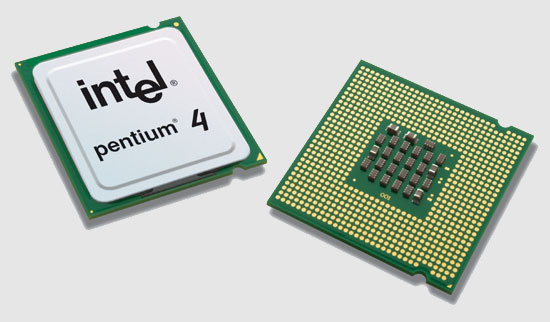Review
Intel 925X Express Chipset
and Pentium 4 3.4 EE CPU Review
Times Are A-Changin’
The PC is ever-evolving, with new features and
technologies brought to market at what feels at times as an almost monthly
basis. Yet this constant influx of new technology is in somewhat stark
contrast to other aspects of the PC that marches to a decidedly slower
pace: form factors, core logic, I/O buses, and other similar industry
standards. Intel, however, is changing this situation this year with the
introduction of the 9xx chipsets and their support for new technologies
such as PCI Express, High Definition audio, the LGA-775, or Socket T,
format, and DDR2 memory. 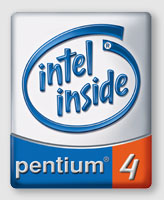 In
fact, one could argue that with this launch Intel is making the most significant
platform change of the past decade. And SimHQ will put the potential real-world
benefits of this new platform, combined with a Pentium 4 3.4 GHz Extreme
Edition processor, to the test by evaluating it against our simulations-based
benchmark suite.
In
fact, one could argue that with this launch Intel is making the most significant
platform change of the past decade. And SimHQ will put the potential real-world
benefits of this new platform, combined with a Pentium 4 3.4 GHz Extreme
Edition processor, to the test by evaluating it against our simulations-based
benchmark suite.
Feature-rich Foundations
The 9xx series is comprised of the 925X (Alderwood) and 915 (Grantsdale) chipsets, the former aimed at high-end enthusiasts and the latter for the mainstream market. The two chipsets are essentially the same in their features list, which is as follows:
- PCI Express Bus Architecture
- Dual Channel DDR2 533 MHz memory
- Intel GMA 900 integrated graphics
- High Definition Audio
- Matrix Storage Technology
- Wireless Connect Technology
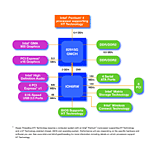 |
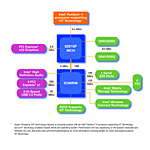 |
 |
| 915g Chipset Process Diagram |
915p Chipset Process Diagram |
925x Chipset Process Diagram |
PCI Express is perhaps of the most interest to hardware enthusiasts, and is certainly the most important change to the PC bus architecture in years. This new I/O bus is a serial, bi-directional connection that gives 2.5 gigabits of bandwidth per lane. With embedded clock signal and data encoding overhead, this translates to roughly 125 MB per second. Yet each PCI Express lane can be grouped with additional lanes, which is where PCI Express graphics comes in; essentially a 16-lane array or configuration, PCI Express x16 improves upon AGP 8X’s bandwidth by a considerable margin. Moreover, its bi-directional design allows for graphics boards to write to system memory, which will certainly facilitate the performance of advanced features such as vertex instancing. The 9xx chipset series will support one x16 slot and up to four x1 slots, the latter useful for expansion boards such as network and sound cards; older PCI slots are also present for legacy hardware support, and what combination of the two is used will be determined by individual motherboard manufacturers. The Intel motherboard used in the test system for this article has four PCI and two PCI Express x1 slots.
The 925X and 915 chipsets both support dual channel DDR2 400 and 533 MHz memory for a system bandwidth of 6.4 GB/sec and 8.5 GB/sec, respectively. The 915 also supports traditional dual channel DDR and manufacturers will be able to support DDR or DDR2, or both. In addition to this increased bandwidth, the 925X’s north bridge chip (82925X) offers increased memory performance over the 915’s (82915P) by inserting “opportunistic maintenance commands” (think improved prefetch commands) in the data path and minimizing latencies by optimizing access times via rearrangement of data stored in memory.
Intel’s Graphics Media Accelerator 900 is the company’s third generation integrated graphics solution, and offers significant features and performance improvements over previous offerings. GMA boasts support for DirectX 9 and OpenGL 1.4, a 333 MHz clock speed, a maximum of 8.5 GB of bandwidth (system bandwidth when used with 533 MHz DDR2 memory), 4 pixel pipelines, and includes hardware support for Pixel Shader 2.0. Worth noting, however, is that Vertex Shader 2.0 support is software-based, so related tasks will be performed by the CPU. And while the GMA’s fill rate and shared system bandwidth are insufficient to allow it to be competitive with even mainstream add-in graphics boards, the impact of its PS 2.0 support with game developers as the 9xx chipsets begin to saturate the market this year could be important in terms of advancing DX9-class technology in upcoming PC titles.
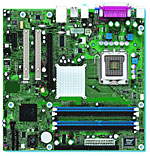 |
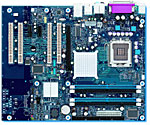 |
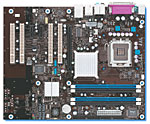 |
| 915g Motherboard | 915p Motherboard | 925x Motherboard |
Integrated audio solutions are often inadequate for the needs of those who seek an immersive aural environment. Intel’s High Definition Audio looks to change that. A 192 kHz, 24-bit 8-channel onboard audio system, HDA also supports audio formats such as DTS, Dolby, and THX. And possibly more important to the business market, HDA also boasts support for 16-element array microphones for superior voice recognition.
Next is Intel’s Matrix Storage Technology, which is essentially Serial ATA RAID support. Offering four Serial ATA ports, Matrix Storage allows for a RAID 0 + 1 setup on only two hard drives. This is possible because rather than being required to stripe (RAID 0) across the full drives, the Matrix technology stripes across half of two drives, and then mirrors (RAID 1) the remaining half. This theoretically gives the disk performance boost of striping while providing the data integrity of mirroring. In addition, the serial ATA ports include Native Command Queuing, which looks to improve performance for even single drives by reorganizing data access commands.
Last, the Wireless Connect Technology is integrated 802.11 g/b support found in the south bridge chip (ICH6RW). PCs sporting the ICH6RW will be able to connect to wireless networks or even act as hubs or access points for new networks. From a hardware or high-end gaming perspective, this technology is probably not the most fascinating of the features listed, but, again, as the 9xx series proliferates throughout the corporate market it could have widespread implications for the adoption of wireless connectivity.
As mentioned above, the Alderwood and Grantsdale chipsets bring perhaps the most significant platform and architectural changes the market has seen over the past decade. PCI Express will eventually replace both AGP and PCI, the GMA 900 graphics could help promote the use of newer graphical features by game developers, and will certainly help maintain Intel’s current leadership in overall graphics market share, and High Definition Audio might seriously challenge the traditional add-in board sound card market. But what good is new core logic — even one as feature-rich as the 9xx series — without the latest in processor technology to drive it?
Prescotts and Socket T
The 925X and 915 chipsets represent
an abrupt move away from the Socket 478 platform by introducing a new
format, LGA775 or Socket T. Intel suggests that this new packaging increases
power and signal delivery, and will thereby give needed headroom as CPUs
continue their inexorable clock speed increases. Besides the pin count
increase, the most interesting aspect of this new socket is the fact that
the pins themselves have been moved from the processor to the socket itself;
LGA (Land Grid Array) refers to the flat contacts on the processor. 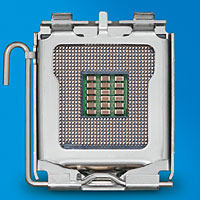 While
the increased pin density will provide superior power and signaling, the
potential disadvantages are added costs handed down to motherboard manufacturers,
who operate within very thin margins for profitability, and possible user
woes if a CPU install goes awry.
While
the increased pin density will provide superior power and signaling, the
potential disadvantages are added costs handed down to motherboard manufacturers,
who operate within very thin margins for profitability, and possible user
woes if a CPU install goes awry.
Alongside the Socket T format, Intel is also introducing a new line of Pentium 4 processors. Based on the core code-named Prescott, these CPUs comprise Intel’s new 5xx series for Socket T platforms. The flagship model is the Pentium 4 Processor 560, a 3.6 GHz CPU, with the 550, 540, 530, and 520 models following suit at 3.4 GHz, 3.2 GHz, 3.0 GHz, and 2.8 GHz, respectively. These CPUs boast a 800 MHz FSB, 1 MB of L2 cache, and SSE3 support, and are manufactured on a 90nm process. The Pentium Extreme Edition 3.4 GHz also included in this review is likewise based on the Prescott core and includes 512 KB of L2 cache, with an additional 2 MB L3 cache.
Interestingly enough, the 5xx series of processors represents another dramatic shift from historical patterns, in that new fabrication processes have traditionally resulted in lowered power consumption and thus less heat. Yet a Prescott CPU consumes roughly 25% more power than its Northwood (130nm process) equivalent. While it is thoroughly reasonable to expect improvements to be made to the manufacturing process Intel employs, this is nevertheless a noteworthy shift away from existing patterns, one that the company itself is well aware of and perhaps seeks to allay the potential negative sales impact of by introducing so rich a feature-set in their 9xx chipsets. Indeed, the adoption of the new naming scheme could itself be an indication that Intel would now like to emphasize clock speeds as a key marketing point less than it previously has in the past.
Test System Setup
- Intel Pentium 4 Extreme Edition 3.4 GHz
- Intel D925XCV motherboard (BIOS CV92510A.86A.0193)
- 1 GB (2x512 MB) Micron DDR2 533 MHz RAM (4-4-4-12)
- NVIDIA GeForce 6800 GT PCI Express graphics board (ForceWare 61.45)
- Maxtor MaXLine III (16 MB buffer) native SATA HD (2x) in a RAID 0 array
- Windows XP Professional (SP1)
- DirextX 9.0b
The benchmark suite that will be used to evaluate this test system is listed here: http://www.simhq.com/_technology/technology_tests.html. Again, unless specified otherwise all games are configured to their highest settings, and 32-bit color and trilinear texture filtering are the default baseline during testing. Also, Windows XP Professional is configured to have Automatic Update, System Restore, and all unnecessary startup services disabled. Fraps v2.2.1 is used to record performance scores unless otherwise noted.
The GeForce 6800 GT is a PCI Express board
clocked at 350 MHz with 256 MB of 500 MHz GDDR3 memory. The 61.45s were
used and manually configured for high quality settings, with trilinear
filtering optimizations disabled.
Benchmarks
First up is the Comanche
4 benchmarking demo. Though several
years old, this piece of software has consistently remained one of the
most CPU-limited titles on the market, refusing to lose more than a few
frames even when tested across a wide range of resolutions. Texture compression
and hardware shaders were checked in the demo’s options.
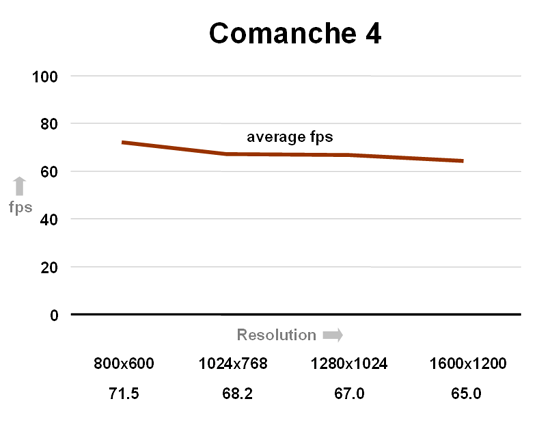
These scores are roughly 10% slower than those from the Athlon 64 FX-53’s SimHQ reviewed earlier this year here but are still amazingly fast when compared to how the demo ran on hardware available at the time of its original release.
Lock On: Modern Air Combat was tested using the MiG-29 Intercept demo. The in-game settings can be found in the reference files on the “How SimHQ Tests” page, and this is the rare title where several settings simply had to be dialed back a notch or two to avoid unacceptable frame rates. The Intercept demo was ran until the six minute mark.
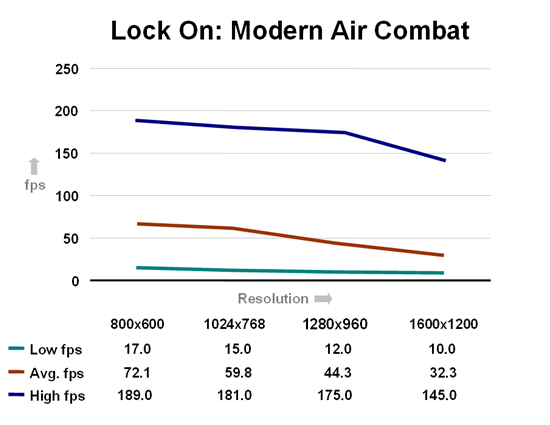
Checking the Fraps log shows LOMAC displaying a trend of below average frame rates while the MIG-29s are still on the ground, with the frames increasing to well above average once airborne. In fact, because the in-flight frames could at times jump so high above the recorded average, due mostly to low camera angles occurring at several points throughout the demo, the sustained frame rate for each resolution should be regarded as roughly 5-7 frames lower than the average.
Microsoft’s Flight Simulator 2004 has proven itself to be fairly stressful on even high-end hardware when its options are dialed to the max. SimHQ’s custom demo consists of a dusk flight over Hong Kong, giving a good combination of water, hilly terrain, and ground structures. The demo is ran with the Spot Plane view active and the camera set directly behind, and frame rate recording is halted upon landing. The only in-game option that isn’t set to its highest option is Ground Scenery Casts Shadows option, which was disabled.
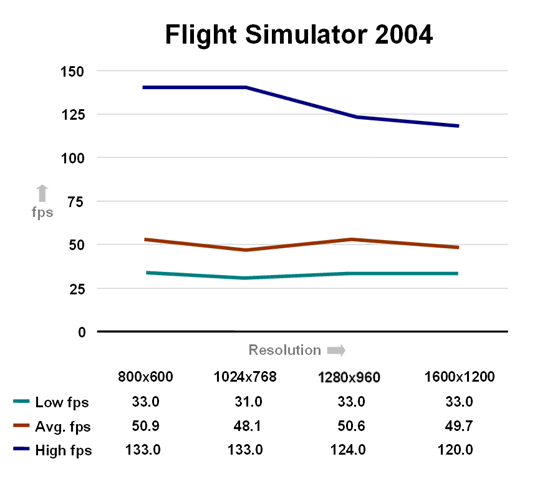
So small a variation in the frame rate clearly indicates that the CPU remains the bottleneck for the game, at least with the settings used during testing.
The IL-2: Sturmovik Forgotten Battles - Aces Expansion Pack represents SimHQ’s non-modern flight simulation test. Using OpenGL rather than D3D, the landscape option was set to perfect. Testing consisted of using Fraps to record the frame rate during the first two minutes of the Bf109 Introduction training demo.
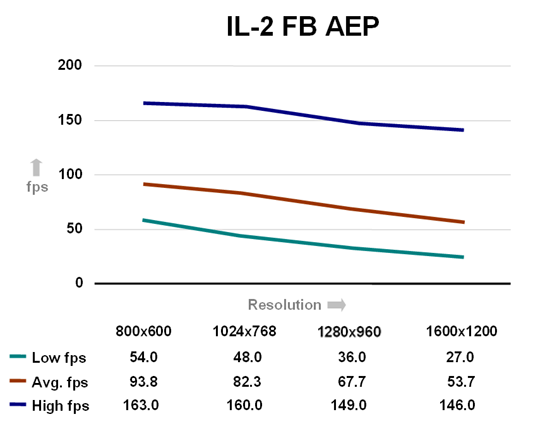
Forgotten Battles scales extremely well with resolution
changes, yet retains playable frame rates even at the highest resolutions.
The venerable Falcon
4 has received a recent overhaul with
the release of SuperPAK 4.1.
We tested the beloved sim with SimHQ’s new demo, a low level, air-to-ground
dusk mission that consists of two Falcons using Mk20s and Mavericks. The
outbound flight route takes the Falcons over the city and straight into
trouble.
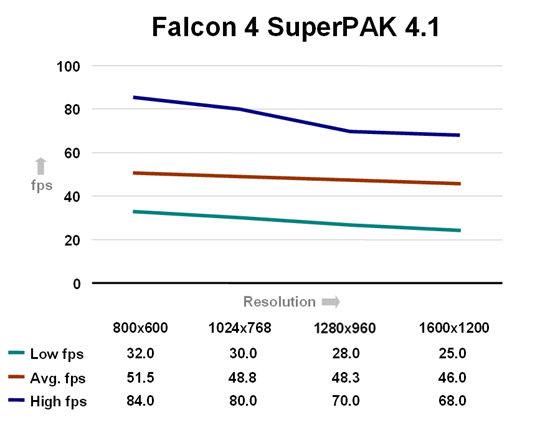
Even with a high-end processor such as the 3.4EE, Falcon 4’s performance still remains tied to the CPU as it loses only 10% across the resolutions tested.
Moving on to land combat, Far Cry is perhaps the most demanding title currently available in terms of hardware needed to run the game smoothly. Unfortunately, the game’s demo recording utility does not capture all graphical effects, such as gunfire, when used, so the testing method chosen was to load a map and basically play through it in its entirety, again using Fraps to log the frame rates. The map Research was picked because it consists of a good mix of beach, jungle, and interior play areas that represent the different environments of the game. Far Cry’s files were edited to allow God mode during testing, and what follows is a brief description of the path taken through the Research map during each test.
The level begins on a small island. Moving to the top of the grassy knoll for a good position, we would then use the sniper rifle to zoom in on enemies across the water. Once out of ammo, we would cross the water heading toward the stone arch along the beach. A helicopter is usually called in at this point, so we would hide beneath the arch until the ‘copter drops off additional enemy troops and flies off. Moving forward, there is a hill to the right where a good firefight ensues with the reinforcements. Once these enemies are dispatched, we would move toward the cliffs, up into the more dense vegetation in the direction of the shack. Grabbing the security card inside the shack we would then use the mortar to clear out any remaining enemies along the beach before heading down the hill on the left and into the cave. Upon reaching the T section in the cave we would go right, clearing enemies until reaching the power switch, and then move toward the elevator room, finishing the level by entering the elevator. The highest recorded frame rates occurred while in the elevator, so the test was ended immediately upon entering the lift.
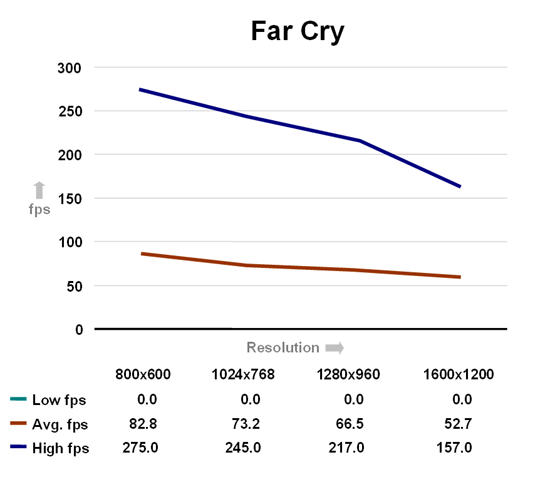
There was a problem between Fraps 2.2.1 and Far Cry when recording was started, causing the game to momentarily freeze for a second and resulting in a false score for the lowest recorded frame rate. Regardless, the game scaled fairly consistently with the resolution increases. It will be very interesting to see what, if any, performance gains are realized with the GeForce 6 chips and the anticipated 1.2 patch and its Shader Model 3.0 support.
For Call of Duty (v1.4), the most recent game in a seemingly new industry of WW2 shooters, the included Dawnville map demo was used with the game’s timedemo utility. The “com_maxfps” command was used to remove the in-game default frame rate limit of 85 (even with Vsync disabled), setting the cap to 500.
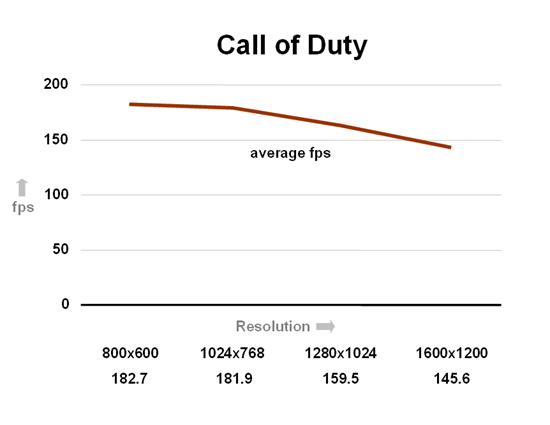
Based on the aging Quake 3 engine, Call of Duty scales extremely well with faster processors, as indicated by the scores above.
NASCAR Racing 2003 Season is SimHQ’s lone motorsports test. Testing was conducted with an in-house demo that makes use of a crowded Daytona track. The camera was locked to Earnhardt’s car and placed in cockpit mode. As usual, all game options were fixed at their maximum settings.
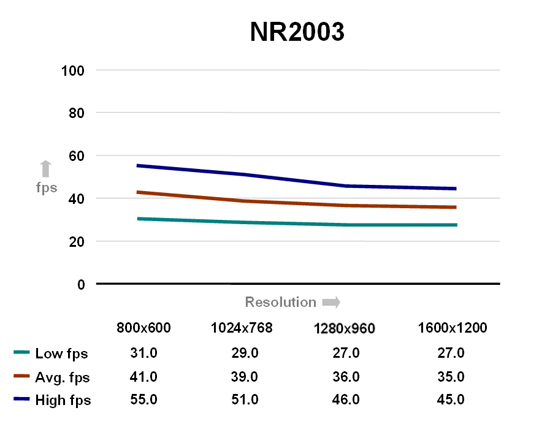
Even at the resolution of 1600x1200 and
a full track, the frame rates remained high enough to provide smooth gameplay.
Nascar, however, is clearly CPU-limited as only a small variation occurred
in the frame rates.
Conclusion
It is hard to become too excited by
200 MHz incremental clock speed increases when such steppings are accompanied
by the high prices historically placed on new processors. Yet the performance
of the 3.4 Extreme Edition cannot be denied, and those seeking bragging
rights with the pockets to afford its price tag should give the processor
consideration. As for the Pentium 4 560 (3.6 GHz), while SimHQ planned
on including its benchmark scores with this article we were simply unable
to run the CPU with the heatsink and fan provided by Intel. Interestingly
enough, while the 3.4 EE would idle with Windows XP loaded at a tolerable
temperature of 34 degrees Celsius, the 560 never dropped below 65 degrees,
and often spiked — unexplainably — above 70 degrees. Perhaps
its current market absence will give Intel time to improve the thermal
issues with the 560. Yet regarding the new socket itself, while much ado
has been made online regarding the LGA775 format’s potential for
broken pins and OEM woes, the installation and removal of the CPUs were
an easy chore so long as they were lowered or lifted as vertically as
possible.
As for Intel’s new platform, the D925XCV motherboard used during testing provided an extremely stable and robust foundation. Incredibly feature-rich, the 9xx chipsets boast enough on board functionality in terms of graphics, sound, and networking that add-in board vendors should feel their market shares quite threatened as the new Intel platform begins saturating the market. Moreover, the GMA 900 is such a significant advancement for integrated graphics in terms of advanced features supported that it could act as the single most powerful market influence on game developers to truly begin including these features in their upcoming titles. Yet it must be stated that Intel seems to be betting rather strongly on these features being the leverage that pushes the new platform into the market, because new technologies such as PCI Express and DDR2 serve to increase costs for those looking to upgrade as they remove the option of migrating existing parts — such as, obviously, current DDR memory or AGP graphics boards — to a new, 9xx-based desktop system. And while there are fewer perceptible gains for the gaming and hardware enthusiast communities with Intel’s new platform than what otherwise might be expected, the company has perhaps laid the groundwork with technologies such as PCI Express and the LGA775 socket for better things to come.
Copyright 2008, SimHQ.com. All Rights Reserved. Contact the webmaster.
